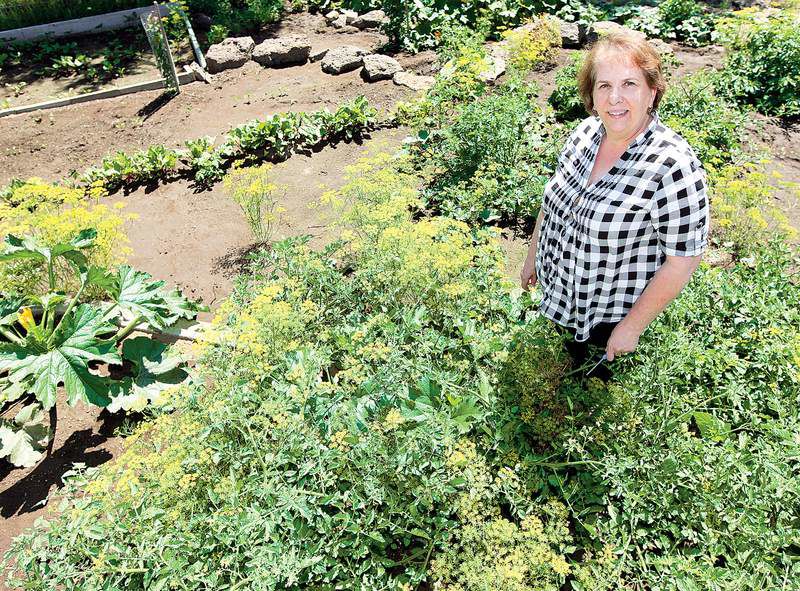Preserve herbs for later
Published 5:00 am Tuesday, August 30, 2011

- Mary Lowe stands in her garden in Redmond. Lowe uses some of the herbs she dries as gifts each year, including small amounts in holiday cards and gift baskets.
It’s so easy to preserve fresh herbs, you’re going to wonder why you haven’t been doing it for years.
Drying, microwaving and freezing backyard-grown and store-bought herbs are simple ways to have fresh seasonings on hand year-round, while also saving a lot of money.
You, no doubt, know that small packages of fresh herbs at the grocery store, which weigh less than an ounce, cost more than $2 each. Small containers of dried herbs in the spice section aren’t cheap either.
“Once you get started on this, you’re going to get hooked,” said Glenda Hyde, family and community health instructor with the Oregon State University Extension Service in Redmond, who grows and preserves a wide variety of herbs at her home.
Hyde’s department offers a variety of classes about food preservation, from pickling and canning to herb growing and drying. She suggests contacting her office or checking its website starting in April of each year to find out what classes will be offered.
Hyde shared tips for preserving some of the herbs that grow especially well in Central Oregon, including basil, chamomile, chives, dill, garlic, lavender, mints (spearmint and peppermint), oregano, rosemary, sage, savory, tarragon and thyme.
Mary Lowe is a volunteer Oregon State University master food preserver who lives in Redmond and enjoys growing her own herbs. She preserves them for cooking and gift giving, and shares her knowledge by teaching those skills.
“I’ve been so happy to discover that some of these herbs I’ve spent a fortune on over the years are readily available out the back door or in my cupboard. It feels so good to pull a few of them down from my shelf, like oregano and thyme, to make spaghetti sauce,” Lowe said.
If you love the way fresh herbs perk up the flavor of your home cooking, get ready for a new hobby.
Air drying: flat
Pick or cut herbs early in the morning, “after the morning dew has evaporated, to minimize wilting,” according to “Drying Herbs,” an online publication from the OSU Extension Service.
Harvest herbs in the mint family when the plants are in full bloom for the best flavor, suggests Deanna DeLong in her book, “How To Dry Foods.” All other herbs should be harvested before their flowers bloom.
After flowering, many herbs develop a bitter taste and the leaves are not as fragrant because their energy has gone into bud-formation, DeLong writes.
Hyde dries thyme leaves in a crockery tart pan.
“I just put it in a sunny window inside and put multiple layers of thyme leaves in it. I strip the leaves off the stems because the stems taste terrible. Dry them for one day, flip them over and they dry out in less than two days,” Hyde said.
Lowe also air-dries most of the herbs she preserves. After harvesting, she rinses them off.
“I pat them dry, gently, because every time you crush them, they release the oils that have all the flavor and aroma in them. Then I lay them out on paper towels and put them on a cookie-cooling rack so there is air flow above and below them,” Lowe said.
In Central Oregon’s hot and low-humidity summer weather, drying can take a few hours or a few days. Larger leaves — like basil, mint and sage — may take up to five to 10 days to air-dry, according to “Drying Herbs.”
Hang-drying herbs
Herbs may be tied in small bunches and hung to dry, indoors or outside.
“If you’re hang-drying herbs in the garage, put a paper bag around them to keep the dust off,” said Hyde.
Hang herbs upside down to cause the flavoring oils from the stems to concentrate in the leaves, according to “How to Dry Foods.”
“Herbs are dry when they crumble easily between the fingers. The stems should be brittle and break when bent, and the leaves should fall from the stems,” according to “Drying Herbs.”
Drying herbs in direct sun is not recommended because it hastens the loss of flavor, aroma and color.
Packaging
Both Hyde and Lowe put the dried leaves into half-pint glass canning jars with lids and store them in cool, dark cabinets.
“It’s tempting to display them because they look beautiful, but a dark place preserves the color better,” Hyde said.
Lowe often stores dried herbs in labeled brown paper sandwich bags.
In order to avoid mold, check jars of dried herbs daily for signs of condensation inside. If moisture appears, the herbs need to be dried longer.
Microwave drying
Small amounts of herbs may be dried in a microwave oven. OSU Extension Service publications recommend never drying more than one to two cups at a time.
Place the herbs between layers of paper towels and microwave on high for 1-2 minutes. Stir and check the herbs every 30 seconds after the first minute, according to “Drying Herbs.”
Hyde cautioned that the woody stems of some basil plants make them prone to catching on fire in a microwave.
Freezing: basil and garlic
One of the most popular uses for basil is pesto. It freezes well in ice cube trays, and then the cubes can be popped out and stored in zip-top plastic bags. Individual cubes can be used in soup, pasta sauce and dressings. Hyde mixes her homemade basil pesto with a little mayonnaise for pesto aioli that she puts on sandwiches.
Hyde also likes to freeze pesto in plastic wrap. She cuts a length of wrap, puts a dollop of pesto down, leaves a space, then drops another spoonful, and repeats to the edge of the wrap. She folds the plastic wrap over the pesto and twists between each dollop, flattening them to get the air out.
“Then fold them up and put them inside a zip-style freezer bag. Clip off what you need,” Hyde said.
Whole, unpeeled cloves and chopped garlic freeze well. Be sure to wrap garlic tightly or everything in the freezer will take on its strong aroma and flavor.
Great gifts and shelf life
Once you’ve harvested and preserved some herbs, get in the habit of using them and sharing them.
Around Thanksgiving and Christmas, Lowe purchases little envelopes and fills them with a tablespoonful or so of an herb she’s dried. She includes them in holiday cards and food baskets.
Freshly dried or preserved herbs will taste best if used within six months to one year.
Using freshly dried herbs in recipes
Dried herbs and spices are usually three to four times stronger than their fresh counterparts because they have been concentrated.
When a recipe calls for a fresh herb or spice, start with a third to a fourth as much of the dried.
Flavor strength varies depending on the type of plant, drying method, storage time and temperature, so be sure to taste as you cook and add more dried herbs and spices as needed.
— From “How to Dry Foods,” by Deanna DeLong, H.P. Books, Fisher Publishing, Inc., 1979
Resources
Deschutes County Food Safety/Preservation Hotline: 1-800-354-7319 (mid-July to mid-September, Monday to Thursday, 9 a.m. to 4 p.m.)
OSU Extension Service, Redmond: www.extension.oregonstate.edu/deschutes or 541-548-6088







